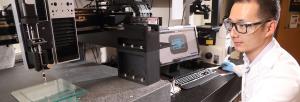
Minecraft is one of the world’s best-selling video games, with 126 million active players across the globe.
In the 3D-mosaic world of Minecraft, everything — animals, houses, even the sun and the moon — is made of small cubes or voxels, the basic building blocks for 3D structures. Players customize the voxels with various functions and colors to construct their own art works. The only limitation is the players’ imagination.
An interdisciplinary team of researchers in the University of Virginia’s School of Engineering and Applied Science and School of Medicine adopted Minecraft’s voxelated approach to advance the field of 3D bioprinting, where the goal is to engineer 3D structures that mimic the geometry, texture, and function of human tissues and organs. Liheng Cai, an assistant professor of materials science and engineering, chemical engineering and biomedical engineering, leads the team.
Their paper, Digital Assembly of Spherical Viscoelastic Bio-ink Particles, termed DASP, is featured as a cover article in Advanced Functional Materials. The team has earned funding from the National Science Foundation Division of Materials Research-Polymers, the American Chemical Society Petroleum Research Fund, UVA LaunchPad for Diabetes, the Virginia Commonwealth Health Research Board and the UVA Center for Advanced Biomanufacturing to support their research.